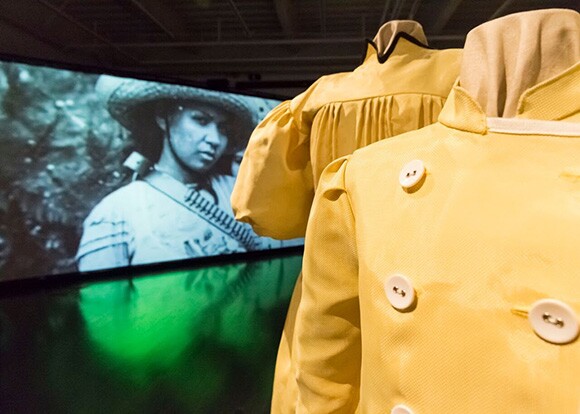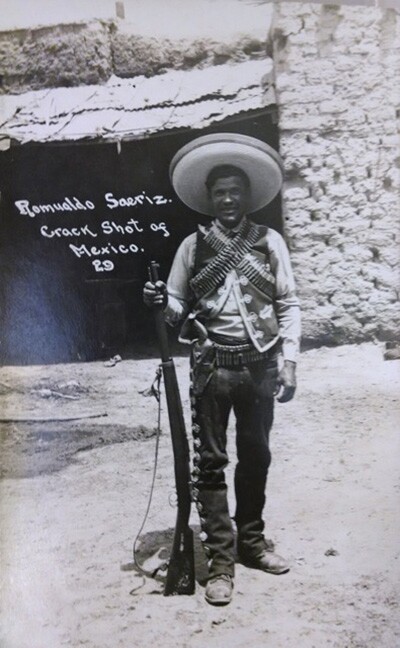Searching for Soldaderas: The Women of the Mexican Revolution in Photographs

Inspired by Nao Bustamante's exhibition, Soldadera -- the artist's "speculative reenactment" of women's participation on the front lines of The Mexican Revolution -- Artbound published articles about the exhibition's development, historical contexts engaged by this project, and writing inspired by the work. Soldadera was guest curated for the Vincent Price Art Museum by UC Riverside professor Jennifer Doyle.
Anchoring Nao Bustamante's exhibition project, "Soldadera" is a film projected onto a 16 foot long, 9 foot high screen. The five-minute loop shows a sequence of rapid-fire images, which are drawn from University of California-Riverside's archival holdings of photographs of the Mexican Revolution. Photos of war flash across the screen; some are quite violent, including photographs of executions. Every now and again, Bustamante holds viewer's attention on an archival image of a woman soldier, a soldadera.
Bustamante's project was initiated by an encounter with a photograph of an all-female battalion of fighters from the Mexican Revolution (1910-1920). For Bustamante, images of women soldiers wearing the long dresses of the period suggest a story about power, violence, gender and vulnerability. That story, for the artist, is about struggle for a better world.

What can these photographs tell us about these women? Like the artist, I was drawn to this body of images. In 2014, I completed a Master's thesis exploring how women presented themselves in photographs of the Mexican Revolution and how those images helped shape public opinion. Like the artist, my own work was inspired by holdings in UC Riverside's library.
The soldadera was a popular 20th-century icon: she remains a powerful but also contradictory figure. She was first imagined as a traditionally feminine heroine; later, she was presented as violent, fearless, and overtly sexual. In the 1960s, her image was adopted by the Chicano movement as a symbol of revolutionary womanhood. The development of the image of the soldadera into a cultural and political icon begins, however, with these photographs of individual Mexican women participating in the war.
The word "soldadera" carries different meanings. During the revolutionary period the soldadera was inaccurately characterized as a selfless and traditionally feminine camp follower who fulfilled the domestic and sexual needs of the men leading the revolution. Despite cultural limitations, women participated deeply in many ways, including by fighting. Despite their widespread involvement in the Mexican Revolution, however, women only figure in a small number of wartime photographs. The comparatively few images of women present them as exceptional rather than common.
These "exceptional" images of women were used to construct a politically gendered identity and purpose. The stories suggested by these images have been re-framed in order to fit them into the political narrative of the Revolution, which asserted a history of "the great men of the Revolution."
Photographs of the Revolution were extremely popular. These images were sold to news outlets around the world, and functioned regionally as propaganda. They were also widely circulated in the form of postcards. People posing for the camera in the context of war were aware that their images were intended for the public. This is significant for women because their stories have been largely silenced. Taken from a different viewpoint, photographs of women revolutionaries afford the opportunity to see the subjects from a position of their self-authorship.
The above postcard portrait of a young woman soldier reflects her active participation in the production of her image. She stands smiling, framed by a bullet-pocked wall and a gaping hole evidencing artillery fire. Her appearance suggests she readied herself for the photograph. In terms of her clothing, she expresses her femininity traditionally, wearing a dress and corset. Her hair, however, is loose and seductive. She characterizes herself as a professional soldier through the objects on her body. Ammunition is strapped to her chest and around her waist. She holds a pair of binoculars in her left hand, a rifle in her right, carries a holstered pistol, and a knife is slung across her hip.

Her display of weapons is similar to that of photographs of male soldiers. Images of fighters like the revolutionary leader Emiliano Zapata and the sharpshooter Romualdo Saeriz also show a desire to characterize themselves through their weapons and clothing. Zapata grips a rifle and sword, is draped in ammunition, and wears a general's sash and formal clothing. His intentionally constructed appearance attempted to prove through the photographic image that he was a decorated General rather than the savage insurgent he was stereotyped as. Saeriz also wears decorative clothing, holds a rifle, and pushes his vest back to ensure his pistol is visible.
Images of women are almost exclusively anonymous, but portraits of men, such as these photographs of Comandante Barrañada and General Benjamin Argumedo, were often inscribed with names. Lower-ranking soldiers like Romualdo Saeriz, nicknamed here "crack shot of Mexico," were also named in photographs. There is no analogous naming of women fighters. Where the mythology of the Revolution was linked to heroic masculinity and individual men, women's roles were controversial which is reflected in their comparative anonymity.
Symbolic factors in these photographs create competing stories. Take, for example, the staging of this postcard image by photographer Antonio Garduño. The anonymous fighter Una Zapatista wears what would have been considered masculine clothing and stares defiantly at the camera. She grasps a sword in her right hand and a Mexican flag in her left. While she has ammunition conspicuously strapped to her chest, she holds no rifle. Her accouterments are politically significant and suggest a symbolic state of warfare and nationhood.
The sword and the flag hold distinct connotations in art history, particularly in paintings of the conquest of Mexico. During the revolutionary period, the flag had special importance as the sign of a new Mexican nation. The sword in the woman's right hand is a traditional symbol of warfare and righteous protection in Western culture. Swords are uncommon in photographs of ordinary revolutionaries, but do appear in portraits of revolutionary leaders in full regalia, as in Hugo Brehme's 1911 portrait of Emiliano Zapata. The woman's sombrero further visually links her to Zapata's forces, and to the characterization of the Revolution as an uprising of the people.

Through these attributes, the Zapatista's image can be read as a symbolic reclaiming by the Mexican people of the nation. In this sense, the woman appears as an anonymous individual, but also as a powerful allegory. At the same time, I see other aspects of her image as being in tension with that shift into allegory. She confronts and defies the performance of her symbolic character through her interaction with the viewer. Her gaze is compelling and we see her first-and-foremost as a person when we meet her eyes.
She is the Zapatista, the allegorical figure, and the anonymous woman soldier defying gender norms at the time.
Photographs of revolutionary Mexican women offer a layered image of the individuals and the roles they played in war and in society at the time. The photographs show how women characterized themselves within the context of war, in images produced for public consumption. The portraits are also symbolically charged. This fact can make a sense of the person's individuality harder to access. These images give us a chance to follow the beginning of the construction of the soldadera as a symbolic figure. For Bustamante, these portraits are thresholds meant to be crossed -- the artist steps inside their world, a world that is as much the product of her mind as it is the product of the photographer's and the viewer's imaginations.


Suggested further reading about the Soldadera and the Mexican Revolution:
Aguilar Camín, Héctor, and Lorenzo Meyer. In the shadow of the Mexican revolution: Contemporary Mexican History, 1910-1989. Austin: University of Texas Press, 1993.
Folgarait, Leonard. Seeing Mexico photographed: the work of Horne, Casasola, Modotti, and Álvarez Bravo. New Haven [Conn.]: Yale University Press, 2008.
Mraz, John. Looking for Mexico: modern visual culture and national identity. Durham: Duke University Press, 2009.
Salas, Elizabeth. Soldaderas in the Mexican military: myth and history. Austin: University of Texas Press, 1990.
Read more about Nao Bustamante's "Soldadera" project:
Nao Bustamante's Soldaderas, Real and Imagined
Nao Bustamante's exhibition "Soldadera" is a "speculative reenactment" of women's participation in The Mexican Revolution.
Dig this story? Sign up for our newsletter to get unique arts & culture stories and videos from across Southern California in your inbox. Also, follow Artbound on Facebook, Twitter, and Youtube.
